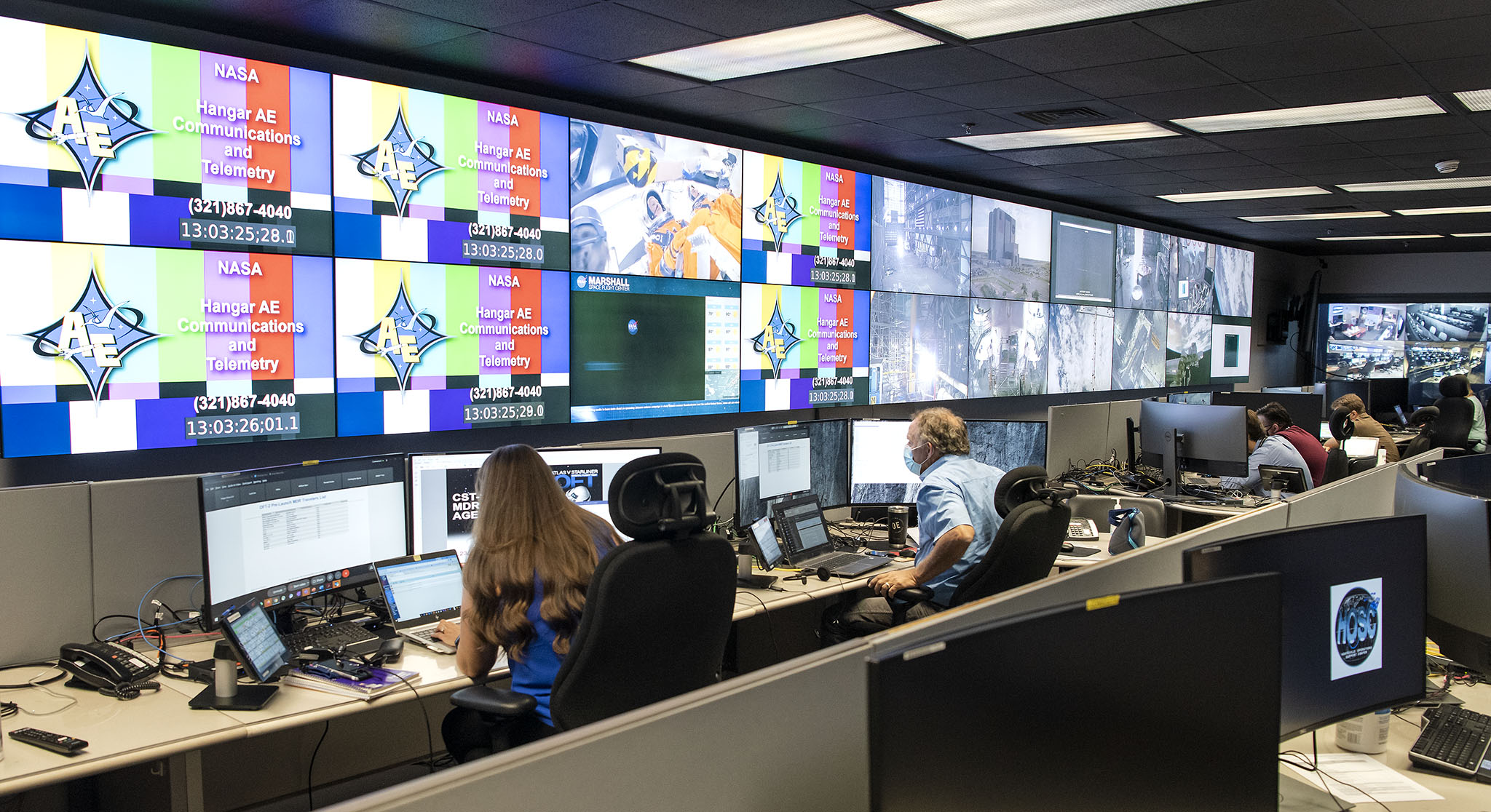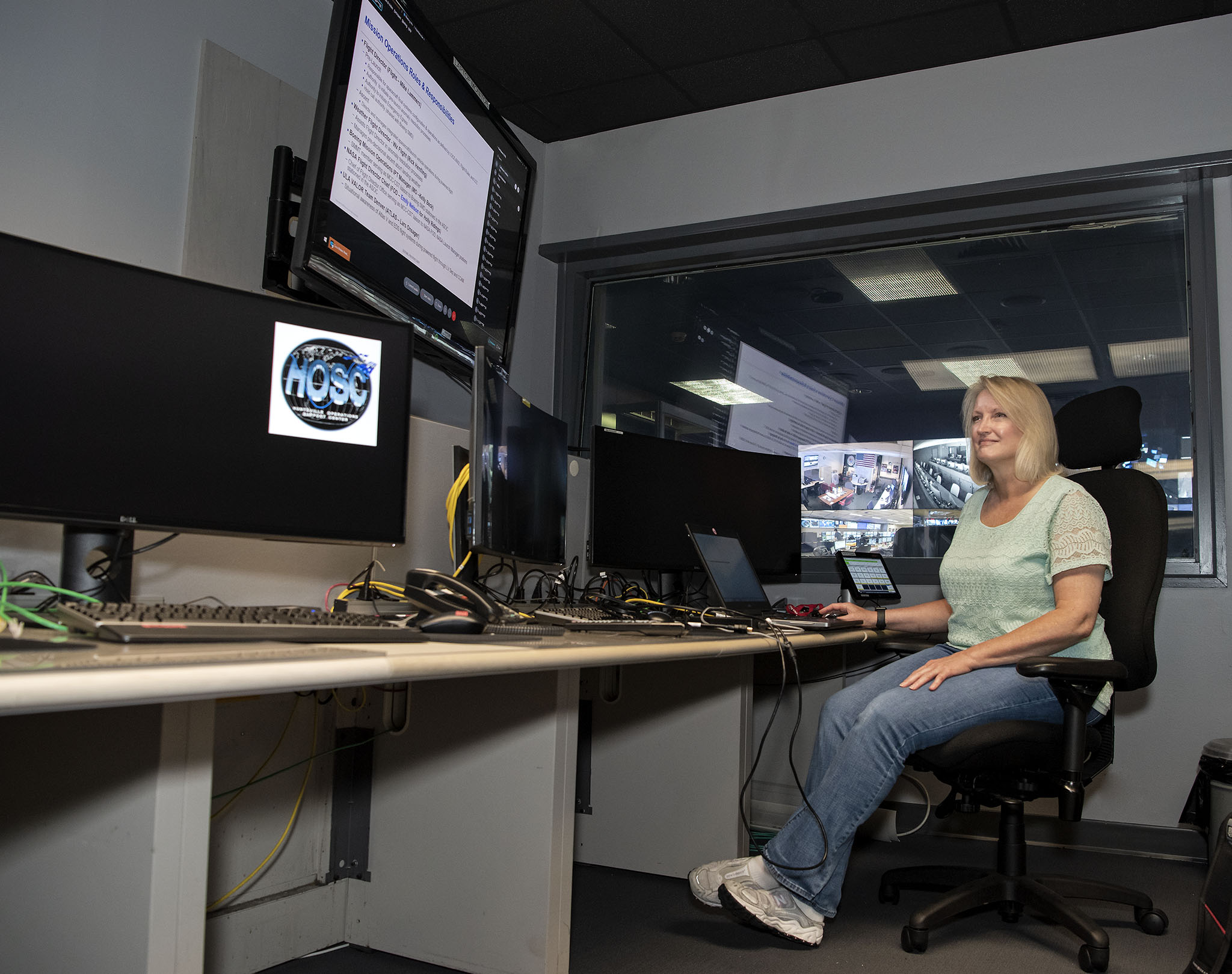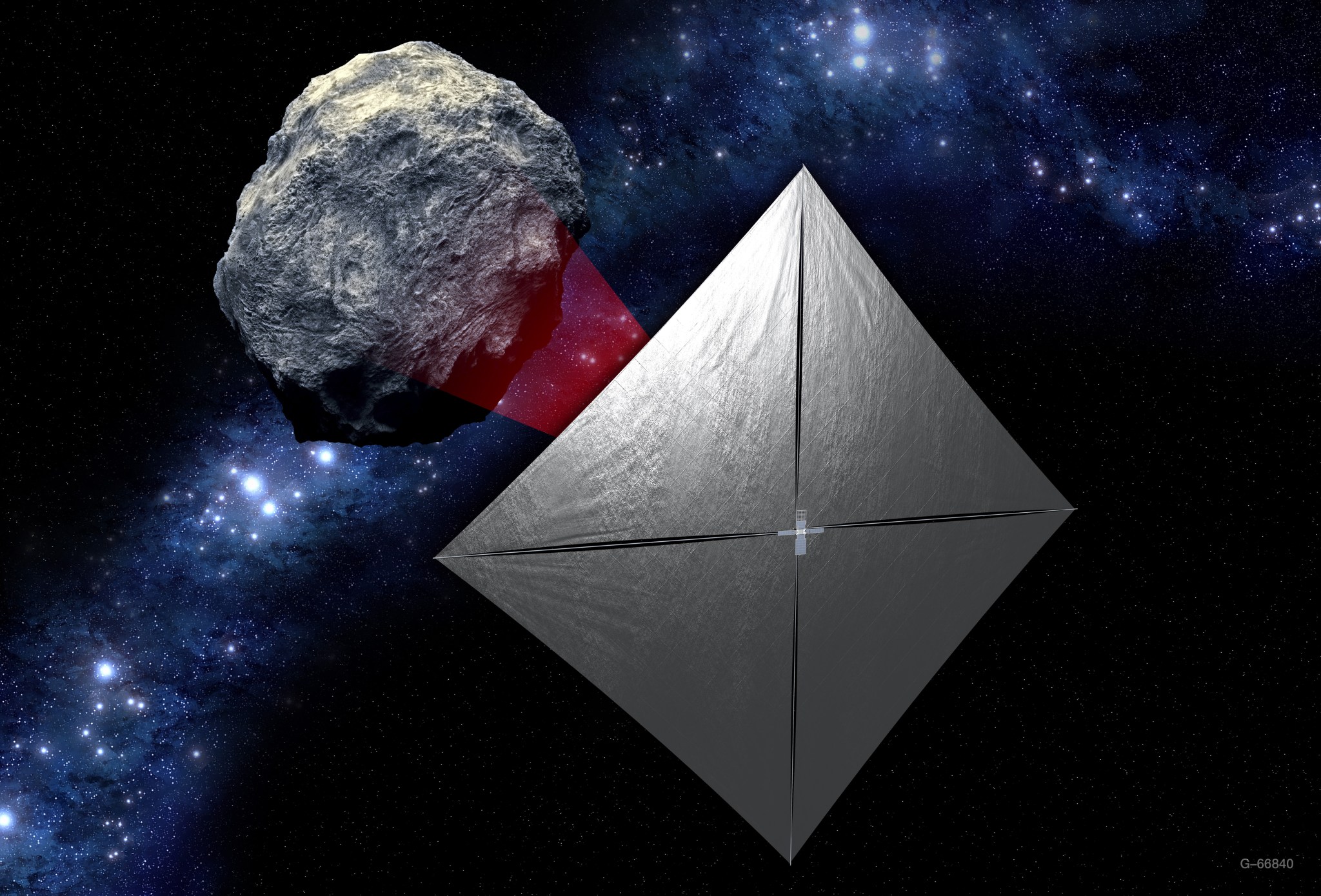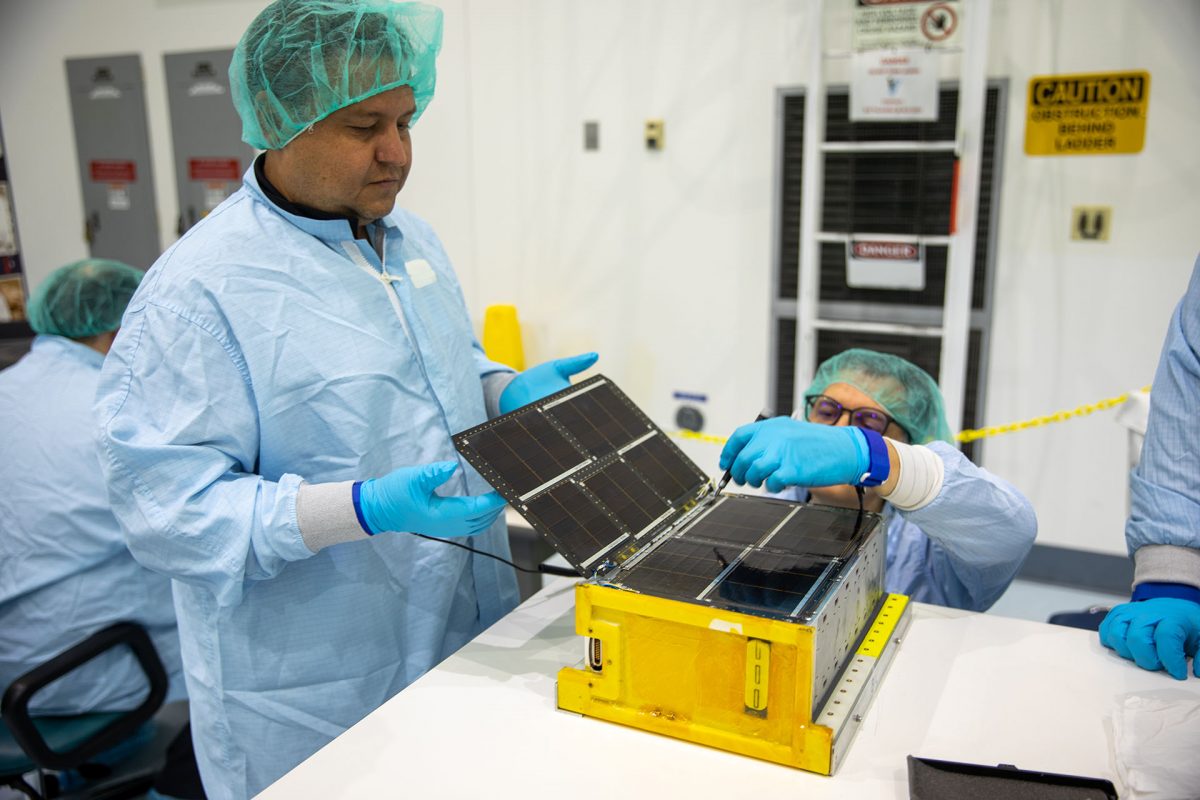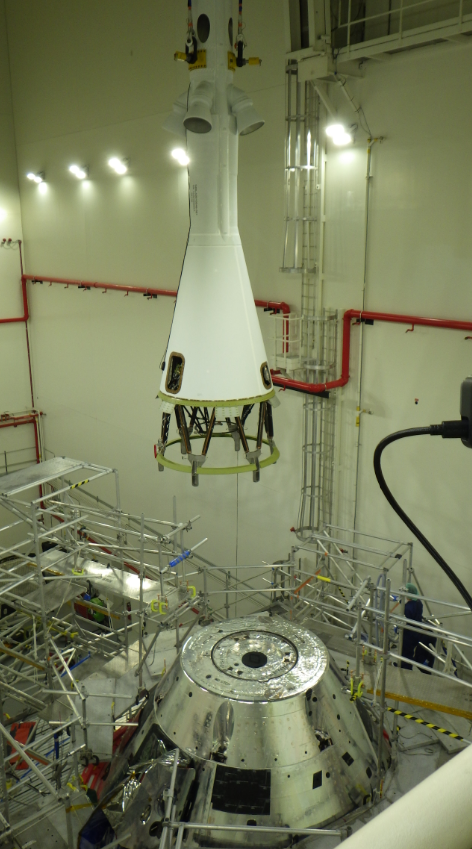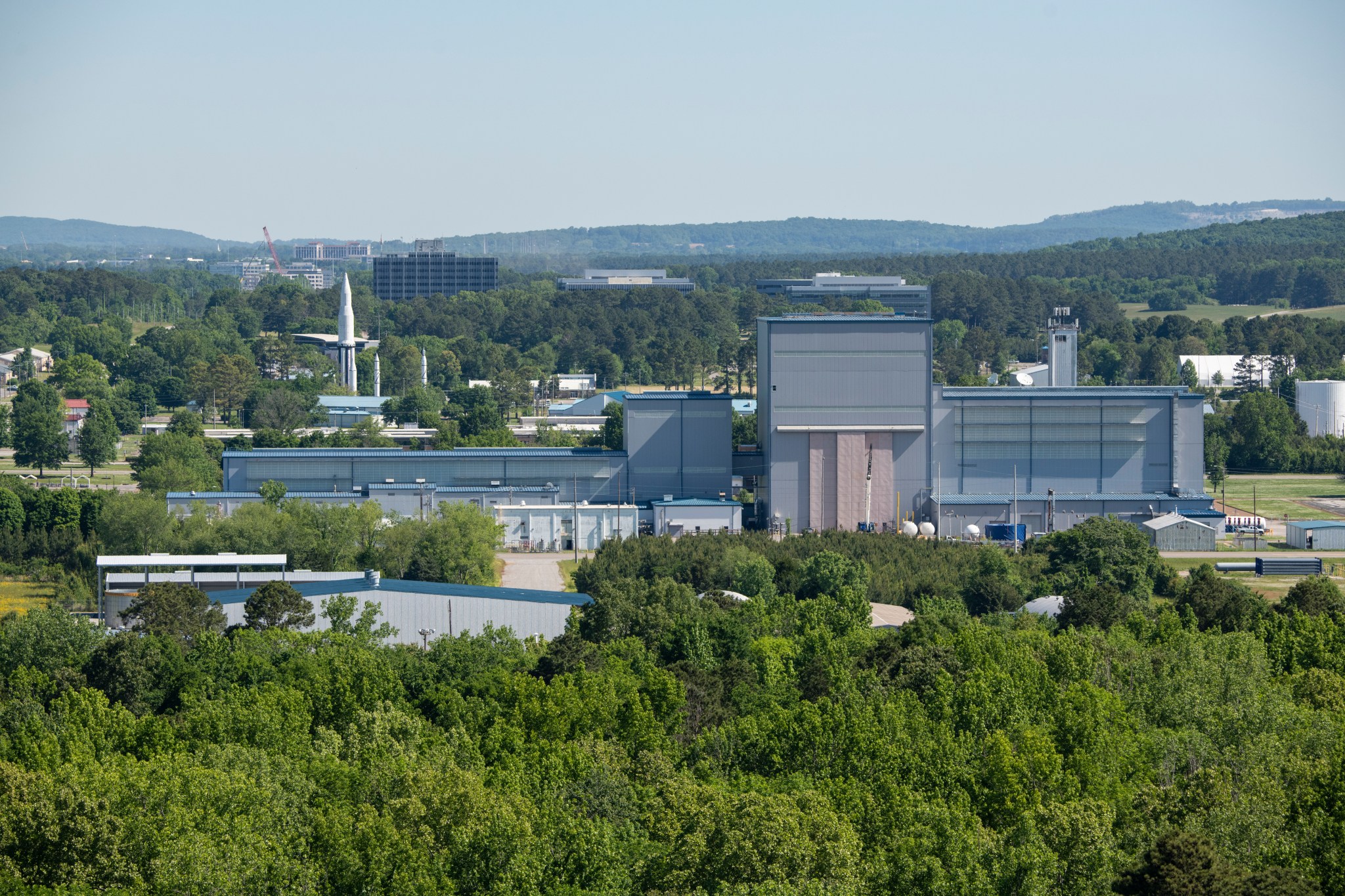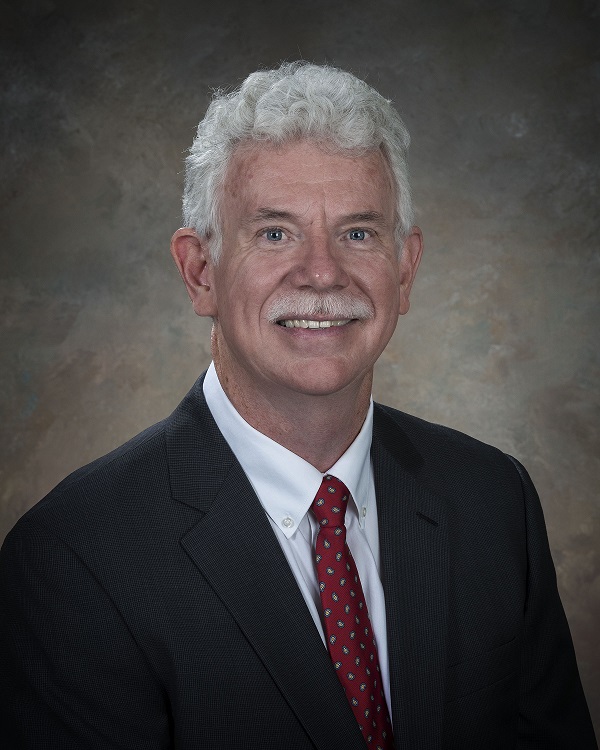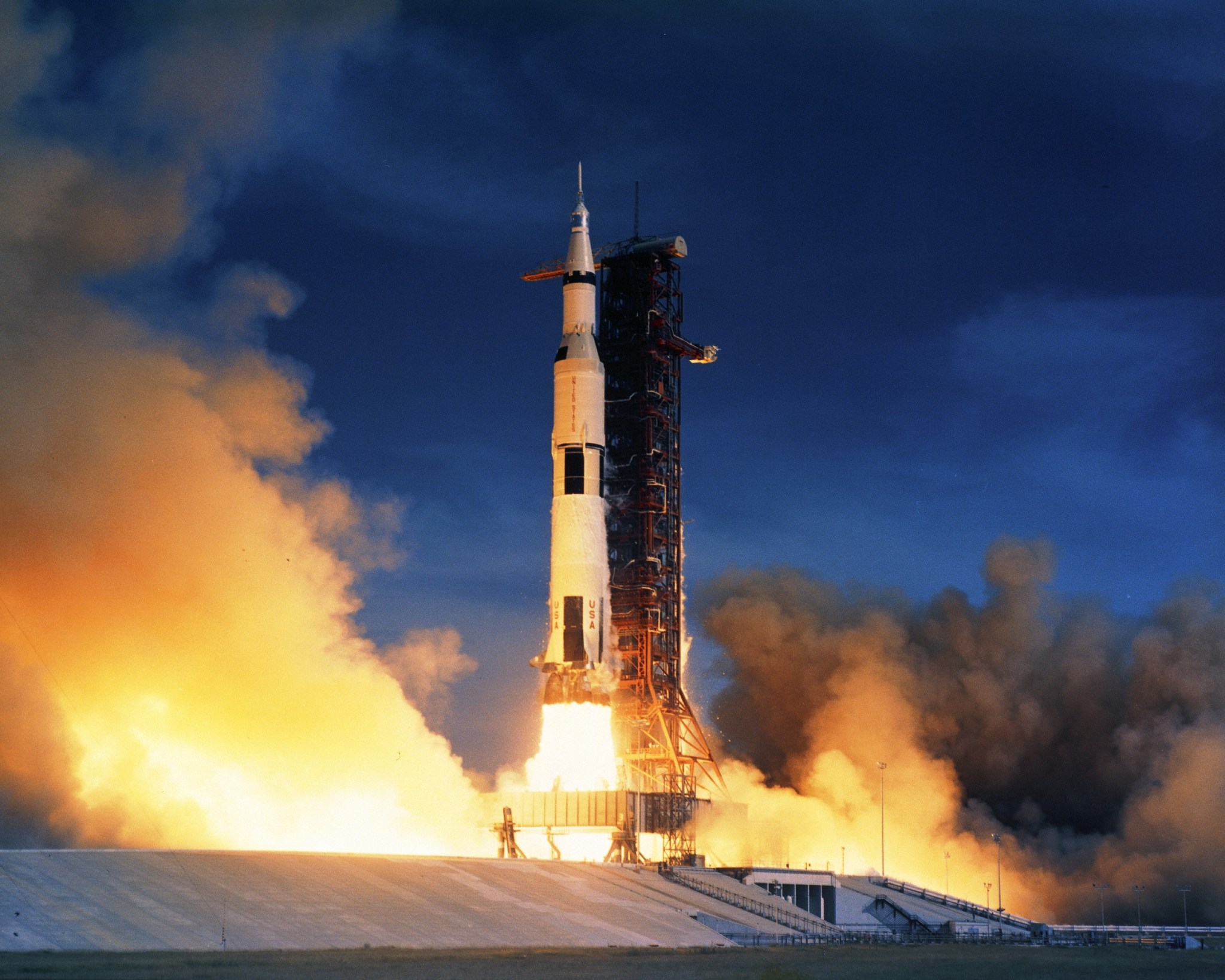Marshall Team Simulates Upcoming Boeing Commercial Crew Launch
On July 23, the Commercial Crew team at NASA’s Marshall Space Flight Center conducted a launch simulation in the Huntsville Operations Support Center in advance of the Boeing OFT-2 launch July 30.
Participants were given potential launch situations to resolve and work through. Using headsets and voice loops to communicate with flight control teams at NASA’s Kennedy Space Center and Johnson Space Center, as well as Boeing, Marshall team members helped analyze simulated data in real time for launch preparations.
The Human Exploration Development & Operations Office at Marshall supports the Commercial Crew Program with engineers that have helped review critical design and development documentation. The team also helps provide oversight to safety standards for the spacecraft and verifies data. For the launch, members of the team will be present in the Huntsville Operations Support Center and will work closely with teams at Boeing, Kennedy, and Johnson to monitor launch conditions.
The Starliner capsule will launch from Cape Canaveral Space Force Station in Florida to the International Space Station on July 30 at 1:53 p.m. CDT. The event will be shown on NASA TV. More information about the launch is available on Inside Marshall.
Catherine Sanders Leads Team Integral to Commercial Crew Launches
By Janet Anderson
As Launch Vehicle Propulsion System manager for NASA’s Commercial Crew Program, Catherine Sanders leads an engineering team that provides insight supporting human spaceflight design and flight readiness certifications of the commercial partners’ rockets. That includes the United Launch Alliance Atlas V that will propel the uncrewed Boeing OFT-2 test flight July 30.
Her team, which includes engineers from both NASA’s Marshall Space Flight Center and Kennedy Space Center, has evaluated technical aspects of rocket propulsion systems.
The Commercial Crew Program was formed to facilitate the development of a U.S. commercial crew space transportation capability with the goal of achieving safe, reliable and cost-effective access to and from the International Space Station and low-Earth orbit.
Sanders’ team has worked closely with ULA to reduce risk and determine safe, cost-effective systems while evaluating rockets for flight as a step toward certifying Boeing’s human spaceflight system for these operational crew missions.
“The safety of our crew is paramount,” Sanders said. “Our team is technically experienced and provides insight into the qualification and critical design reviews for the propulsion systems our commercial partners use to propel their rockets.”
Sanders and her team are prepared to support the OFT-2 test flight and will leverage their experience from certifying and flying the initial OFT test flight that launched Dec. 20, 2019. She and some members of her team will be on console at Marshall’s Huntsville Operations Support Center, while others will provide propulsion support from Hangar AE at Cape Canaveral Space Force Station in Florida.
“We have been anticipating the Boeing OFT-2 test flight since the original OFT launch and we feel even more confident in both our design and flight readiness certifications,” Sanders said. “The launch of OFT-2 is another major step on the path to continue regular human spaceflight launches by commercial companies to the station, so we are eager to evaluate this test flight and begin final certifications for the crewed Boeing CFT test flight planned for later this year.”
Sanders has over 30 years of aerospace experience and has been in her current role since 2016 and with NASA since 2000. She is a Huntsville native with a significant NASA influence – her parents were among some of the Marshall’s early employees. Her father, James Brewer, retired from Marshall after a long career as an aeronautical engineer, while her mother, Patricia Brewer, worked at the center until 1967 as a program analyst. The family has a third generation at NASA as Sanders’ daughter, Allison Sanders, is currently an intern at Marshall.
Sanders sees the Commercial Crew Program as a way to leave a lasting mark on the space industry. In addition to the Boeing test flights, her team also supported design and flight readiness certifications for the SpaceX uncrewed Demo-1 test flight in 2019 and the SpaceX crewed Demo-2 test flight and Crew-1 and Crew-2 missions flown over the past year. She believes NASA has sufficiently paved the way for commercial companies to develop and maintain crew at the space station, while the agency looks to missions beyond low-Earth orbit.
While the team is preparing for OFT-2 and Crewed Flight Test, they are also preparing for the SpaceX Crew-3 mission planned for Oct. 31. Sanders said that she is “privileged to work with the smartest and most hard-working folks in propulsion” and with the experience gained working this commercial model, she hopes her team can influence other NASA projects and programs that are planning this same type of approach.
Sanders’ team has worked long hours through furloughs, holidays, and the COVID-19 pandemic. Through it all, nothing could dampen their spirit of exploration.
“Fortunately, we love what we do,” she said. “I feel these are the good old days.”
Anderson is a public affairs officer in Marshall’s Office of Strategic Analysis & Communications.
CubeSats Installed for Artemis I Mission
Over the past week, the first seven secondary payloads were installed in the Space Launch System rocket’s Orion stage adapter at NASA’s Kennedy Space Center, for launch on the Artemis I mission.
The stage adapter connects the Orion spacecraft to the SLS rocket and will carry the CubeSats and deploy them after Orion departs for its lunar exploration mission.
The CubeSats are:
- NEA Scout will be the first CubeSat to travel to an asteroid. The small payload was developed by NASA’s Marshall Space Flight Center and the agency’s Jet Propulsion Laboratory. NEA Scout will be propelled by a square-shaped solar sail that will measure about 925 square feet when unfurled. The sail is made of an aluminum-coated plastic film that is thinner than a human hair, with an area about the size of a racquetball court. NEA Scout is outfitted with a high-powered camera that will take photographs of and collect data from a near-Earth asteroid that represents asteroids that may become destinations for human exploration. Observations will include the asteroid’s position in space, its shape, rotational properties, spectral class, and geological characteristics. NEA Scout’s mission will take approximately two years.
- Lunar IceCube will search for water ice and other resources from above the surface of the Moon. It was developed by Morehead State University in Kentucky, Busek Space Propulsion and Systems of Natick, Massachusetts, NASA’s Goddard Space Flight Center, JPL, and NASA’s Katherine Johnson Independent Verification and Validation Facility. Once deployed, the CubeSat will take up to nine months to arrive at its destination and begin orbiting the Moon. Using state-of-the-art miniature electric thrusters for propulsion and relying on gravity assists from Earth and the Moon, Lunar IceCube will search for water and other materials in ice, liquid, or vapor states that may be useful for future exploration missions. Once in orbit, Lunar IceCube’s mission could last one to six months and the ground station at Morehead State will be used to track the CubeSat for the duration of the mission.
- Lunar Polar Hydrogen Mapper, or LunaH-Map, was developed by Arizona State University in Tempe and sponsored by NASA’s Science Mission Directorate, LunaH-Map will measure the distribution and amount of hydrogen throughout the Moon’s South Pole. If successful, the spacecraft will produce a high-resolution map of the Moon’s bulk water deposits, unveiling new details about the spatial and depth distribution of potential ice previously identified during a variety of missions. Confirming and mapping these deposits in detail will help NASA understand how the water got there, how much water might be available, and how it could potentially serve as a resource for longer exploration missions on the Moon. The CubeSat’s mission is designed to last around 60 days.
- LunIR was developed by Lockheed Martin Space in Denver and sponsored by NASA’s Advanced Exploration Systems division under the Human Exploration and Operations Mission Directorate. The CubeSat will conduct a lunar flyby and use an advanced miniature infrared sensor to gather images and data about the lunar surface and its environment. This effort will help collect data to address knowledge gaps related to transit and long-duration exploration to Mars and beyond. The CubeSat will collect data about the lunar surface, including material composition, thermal signatures, presence of water, and potential landing sites. LunIR’s infrared sensor will be able to map the Moon during day and night and can collect data at much higher temperatures than similar sensors, thanks to an innovative micro-cryocooler – similar to a refrigerator – designed to reach cryogenic temperatures below minus 234 degrees Fahrenheit.
- The Team Miles CubeSat, developed by Miles Space in partnership with software developer Fluid & Reason LLC, will travel to deep space to demonstrate propulsion using plasma thrusters, a propulsion that uses low-frequency electromagnetic waves. The CubeSat was developed as part of NASA’s Cube Quest Challenge and sponsored by the agency’s Space Technology Mission Directorate Prizes, Challenges, and Crowdsourcing program. Team Miles’ mission will be flown autonomously by a sophisticated onboard computer system. In addition, the breadbox-sized spacecraft will use a software-defined radio for communications with Earth. If successful, the CubeSat will travel farther than this size of craft has ever gone – 59.6 million miles.
- CubeSat to Study Solar Particles, or CuSP, will be deployed for an interplanetary mission to study the particles and magnetic fields that stream from the Sun. CuSP was developed by the Southwest Research Institute, Goddard, and JPL and is also sponsored by the Science Mission Directorate. This CubeSat will orbit the Sun with three instruments to measure incoming radiation and the magnetic field that can create a variety of effects on Earth, such as interfering with radio communications, tripping up satellite electronics, and creating electronic currents in power grids. CuSP can observe events in space hours before those events potentially reach Earth.
- The EQUilibriUm Lunar-Earth point 6U Spacecraft, or EQUULEUS, developed jointly by the Japan Aerospace Exploration Agency and the University of Tokyo, will travel to Earth-Moon Lagrange Point 2, an Earth-Moon orbit where the gravitational pull of the Earth and Moon equal the force required for a small object to move with them. The CubeSat will demonstrate trajectory control techniques within the Sun-Earth-Moon region and image Earth’s plasmasphere, a region of the atmosphere containing electrons and highly ionized particles that rotate with the planet. EQUULEUS will measure the distribution of the plasmasphere, providing important insight for protecting humans and electronics from radiation damage during long space journeys. The CubeSat will also measure meteor impact flashes and the dust environment around the Moon, providing additional important information for human exploration. EQUULEUS will be powered by two deployable solar arrays and batteries, propelled by a warm gas propulsion system with water as the propellant.
Launch Abort System for Artemis I Stacked, Ready
The Orion spacecraft for the Artemis I mission recently completed stacking, fueling, and servicing checks while inside the Multi-Payload Processing Facility at NASA’s Kennedy Space Center.
Crowning the spacecraft with its aerodynamic shape, the launch abort system is designed to pull crew away to safety from the Space Launch System rocket in the event of an emergency during launch. This capability was successfully tested during the Orion Pad Abort and Ascent Abort-2 tests and approved for use during crewed missions.
Teams with Exploration Ground Systems and contractor Jacobs added parts of the launch abort system onto the spacecraft. Technicians will install four panels that make up the fairing assembly and protect the spacecraft from heat, air, and acoustic environments during launch and ascent. A launch tower tops the fairing assembly to house the pyrotechnics and a jettison motor. The system will also be outfitted with instruments to record key flight data for later study.
With successful demonstration of the system during previous tests, the abort motor that pulls the spacecraft away from the rocket and attitude control motor that steers the spacecraft for a splashdown during an abort will not be functional for the uncrewed Artemis I mission. The jettison motor will be equipped to separate the system from Orion in flight once it is no longer needed, making Orion thousands of pounds lighter
Inside Kennedy’s Vehicle Assembly Building, the launch abort system joined the already stacked flight hardware and was raised into position atop the SLS rocket, marking the final assembly milestone for the Artemis rocket.
Launching in 2021, Artemis I will be a test of the Orion spacecraft and SLS rocket as an integrated system ahead of crewed flights to the Moon. Under Artemis, NASA aims to land the first woman and first person of color on the Moon and establish long-term lunar exploration.
Rocket Science in 60 Seconds: How Structured Light Scanning Is Used on the SLS Rocket
Mary Kalayjian, an Aerojet Rocketdyne project and component engineer for the RS-25 engines on NASA’s Space Launch System rocket, explains how a process called structured light scanning allows teams to build and assemble smaller components of the RS-25 engine precisely and quickly. The four RS-25 engines at the bottom of the SLS rocket will produce more than 2 million pounds of thrust to help launch NASA’s Artemis missions to the Moon. At its rocket factory in California, Aerojet Rocketdyne is building new engines for SLS missions beyond Artemis IV. (NASA)
Take 5 with Brian Key
By Daniel Boyette
Brian Key could feel the pressure wave. He heard windows in his home rattle. But even as a child, this was no moment of fear. The son of a Kennedy Space Center employee, Key was watching a rocket launch from his backyard – a common occurrence for a kid growing up on the Space Coast of Florida in the 1960s and 1970s.
“The sensation was awe-inspiring and I knew that I wanted to be part of the team that was putting people into space,” said Key, manager of the Planetary Missions Program Office at NASA’s Marshall Space Flight Center since 2018 and a member of the office since 2009.
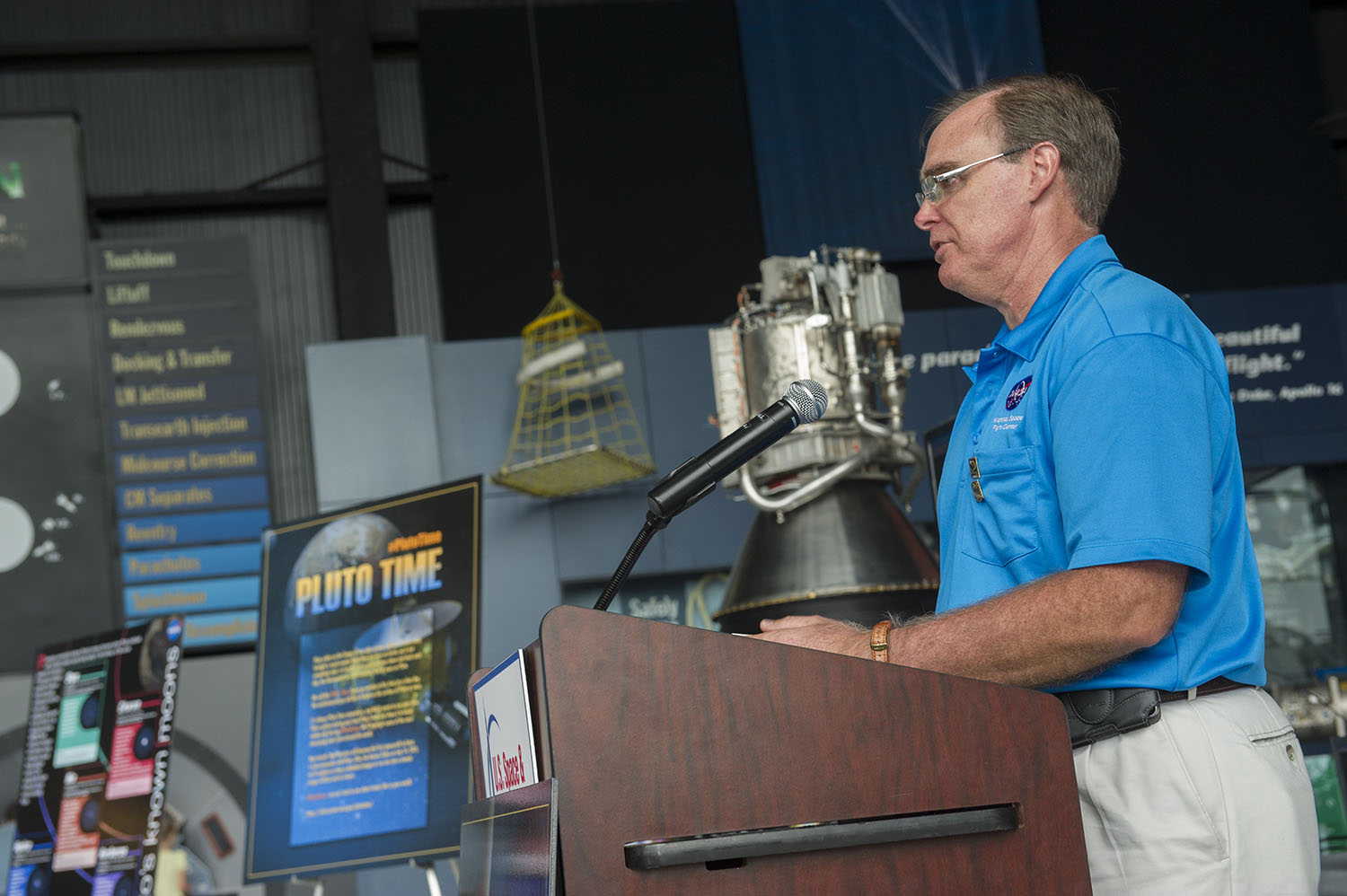
Key’s office oversees the Discovery, New Frontiers, and Solar System Exploration programs, which have produced missions that investigate planetary bodies, dwarf planets, comets, and asteroids by gathering data through flybys, collecting samples for return to Earth, and performing landed measurements.
“There is always something new and exciting happening,” he said.
Question: How do you encourage teamwork, collaboration, and integration, especially in this unprecedented telework environment?
Key: Teamwork, collaboration, and integration are inherent elements of a Level 2 Program Office. All projects and missions within the Planetary Missions Program Office are managed at centers or institutions outside of Marshall. Because of this, office personnel must engage and connect with the project and mission teams at these other centers or institutions. Pre-COVID-19, we were able to travel and have in-person meetings, allowing relationships to be formed and nurtured. When COVID hit, the office initially struggled, not only with maintaining awareness of all the project and mission statuses but keeping the overall office personnel coordinated and informed. I was impressed with how quickly our team adapted and innovated to the remote work conditions. Working from home has introduced new challenges and our teams – program, project, mission, and HQ – have found ways to stay connected and integrated, leading to more robust constructs for conducting our life cycle and Key Decision Point reviews. Encouragement to have increased and frequent communications at all levels has been the mantra of the office.
Question: How are you managing your personal and your team’s work-life balance, especially now, more than a year into the COVID-19 pandemic?
Key: In the first year of the pandemic, for me this was one of those “do as I say and not as I do” areas. During this telework period, I routinely encouraged employees to take time away from their computer screen and remember to take time for themselves and their families. For myself, with the need to have focused increased communications with my team, I tended to let my work pile up throughout the day and then worked late in the evening to catch up. Thankfully, I have been able to delegate more responsibility to the office leadership team, enabling me to complete have more routine work hours.
Question: How does your team honor and demonstrate NASA’s commitment to creating a diverse and inclusive environment where team members are valued for their unique contributions?
Key: Creating and maintaining a diverse workforce requires constant evaluation of the makeup of our office team. Recruiting opportunities are limited due to the experience requirements of positions within the office, therefore we rely on competitive hiring opportunities. To increase the infusion of more diverse individuals, all members of the office are encouraged to participate in our outreach efforts that are targeted at underrepresented elementary and secondary schools, where we encourage the pursuit of science, technology, engineering, and math careers at NASA. Inclusion occurs when all team members feel like they belong in the office. For our office, that means everyone can voice their opinions and they don’t feel excluded or have a fear of reprisal. When someone new becomes part of the office, I make it a point to let them know that I value what they bring to the office and expect them to voice their opinions, even if they are contrary to my own. There is always room to improve how things are done and all opinions are worth considering when trying to continuously improve how we do our jobs.
Question: What key partnerships are your team pursuing to help NASA build and develop a sustainable presence on the Moon? Help push the boundaries of science, technology, and/or human exploration?
Key: The Planetary Missions Program Office has been asked to take on work that falls outside our normal Discovery, New Frontiers, and Solar System Exploration programs responsibilities. This new effort is in support of the Science Mission Directorate’s Lunar Discovery and Exploration Program and consists of managing 12 Lunar Surface Instrument Technology Payloads – commercially developed instruments that will be transported to the Moon via the Commercial Lunar Payloads Service – and three Payloads and Research Investigations on the Surface of the Moon – instrument suites with focused science objectives that are also transported to the Moon via the commercial service. For both efforts we are working with commercial vendors and academic institutions.
Question: Why do you think your team is successful at staying mission-focused?
Key: The Planetary Missions Program Office serves as an advocate for the assigned projects and missions, drawing on the talents and expertise within Marshall to provide support to our projects and missions when needed. For our office, mission success is ensuring that missions accomplish their science objectives and return the science data to the ground for archival and further scientific analyses. The office successfully maintains mission focus primarily because our missions have relatively short implementation and development durations, providing office personnel the opportunity to follow a project or mission through the entire project development life cycle and operations. Additionally, our missions are really cool, from flying a robotic rotorcraft on Saturn’s moon Titan to returning a sample from the asteroid Bennu!
Boyette, an LSINC Corporation employee and the Marshall Star editor, supports Marshall’s Office of Strategic Analysis & Communications.
As NASA Again Named Best Workplace in Federal Government, Employees Show Desire for Future Telework Options
By Khelyn Mickles
For the ninth consecutive year, NASA has been named the best place to work in the federal government. The rankings are based on responses to the Office of Personnel Management’s annual Federal Employee Viewpoint Survey. The past year presented the agency and NASA’s Marshall Space Flight Center with a host of changes and challenges with regard to working through the COVID-19 pandemic, and the answers were reflective of the evolving work climate.
“The EVS is an important tool for us to help keep Marshall Space Flight Center a great place to work, and I want to thank everyone who responded for your valuable insight,” Marshall Director Jody Singer said. “We are honored for our agency to be named the best place to work yet again. During a tough year, our employees have persevered. You are the most important part of what we do, and doing it right. That includes continuing our efforts to build and maintain an inclusive culture. I am committed, and I require my team’s commitment, to getting better every day.”
The Office of Personnel Management uses the survey to measure how federal employees perceive different aspects of their organizations. It helps federal leaders determine what characteristics of successful organizations are present within their agency. More than 64% of NASA employees responded this year.
With regard to telework, the survey revealed that most employees can and want to continue working off-site for a large portion of their time. More than 80% of employees positively perceived mission success with the blend of on-site and off-site work. Although workload has increased, employees reported that they do feel supported by supervisors and leadership.
“Results for Marshall were positive, overall, with slight increases in employee engagement and satisfaction, and increased satisfaction with the agency’s telework programs and alternative work schedules, which are important during the current pandemic,” said Larry Mack, Human Resources deputy director at Marshall “Additionally, according to the survey results, Marshall supervisors and leadership have done a great job providing broad support for employees, their well-being needs, and their work during the COVID-19 pandemic.”
To realize the changes employees wish to see, NASA has established the Future of Work team, which will lay out guidance in creating a future that supports employees continuing to have flexibility in how and where they work. Agency leadership and the Future of Work team are using employee feedback to understand employee needs and provide guidance to supervisors for managing a distributed, or partly distributed, hybrid workforce.
Marshall employees reported overall positive results and increases in employee engagement and satisfaction with the agency’s telework programs and alternative work schedules over last year. They also want continued support for collaboration and accomplishing organizational goals in the telework environment. For example, 96% of respondents indicated that their work unit was able to effectively collaborate most of the time or always prior to the pandemic compared to 91% during the pandemic.
The survey gave employees the opportunity to share their perceptions about work experiences and preferences for on-site and off-site work, and give center leadership clear insight into areas where improvements have been made and are needed. Although such results remain positive, discovering and honing ways to better facilitate collaboration across working groups helps to lessen the impacts of the pandemic on employees and their work, Mack said.
Additionally, approximately 73% believe the results of the survey will be used to make the agency a better place to work, and Marshall plays an integral role in this. Mack said that sharing the results across the center and making positive changes based on these results can help positively influence response rates in the future.
Detailed results can be found on the 2020 Federal Employee Viewpoint Survey.
Mickles, an LSINC Corporation employee, supports Marshall’s Office of Strategic Analysis & Communications.
We’ve Kept Calm and Carried On: Focusing on Gratitude, Resilience Can Help Combat Uncertainty
Dear Marshall family,
Here we are at the end of July, and the heat and humidity typical of Alabama summers have finally arrived. If you work (or play) outdoors, please be careful about getting overheated, and please stay hydrated. This is a very active time of year and many of us have taken some time away from work this summer to rest, recuperate, or get some projects completed around the house.
School will be starting in a couple of weeks. Colleges will be starting fall semester in a few weeks. People are starting to talk even more about football, as they look forward to local and college sports. And – oh, yes – the COVID-19 pandemic continues.
I’m so thankful that things have gotten better in regard to COVID-19, and I want to encourage you to continue to be vigilant and take precautions in order to keep the infection rates down. If you haven’t gotten your vaccinations, please consider doing so.
You all know that the past 16 months have been hard, and me saying it here is certainly not news. However, I would like to ask you to join me now in taking a few moments to focus on the simple fact that we have persevered. Day after day, we have kept doing what we needed to do in order to try to stay safe and keep our loved ones safe, and also to remain productive and keep contributing to our families, our work teams, and our communities. Yes, it has been hard, but we have met the many challenges and we have persevered.
I think we all probably have moments when we think, “Here we go again!” or “When is this going to be over?” or “How can I keep dealing with all this uncertainty?” One powerful way to fight against the exhaustion and frustration of it all is to remind ourselves how far we have come. Reframing our thoughts from, “How am I going to keep doing this?” to “I’ve been doing this for months and even though it isn’t always easy, I am getting through it” can have a positive impact on our perspective, attitude, and mood. Often, if we pause to notice, we can see in our loved ones or others examples of strength and positive adaptation that are truly inspiring.
We have much for which to be thankful. Many things have improved and are expected to be at least somewhat closer to normal this school year. Nursing homes and other facilities have begun allowing visitors, and we can once again spend time with our loved ones there. We still have our jobs, and each one of us contributes in some way to the success of projects that will continue to improve the state of humankind for years to come. We have leadership that continues to assure us that the safety of the workforce is top priority, and who have consistently demonstrated the truth of that ideal over these past 16 months. We can be confident that as we transition toward more on-site work, whenever that may be, they will continue to lead with the well-being of the workforce front and center. Pausing to consider these and the many other positive things in our lives is another tool that we can use to adjust our perspective, attitude, and mood in a positive direction.
I want to leave you today with a reminder to be vigilant and keep taking precautions related to the spread of COVID-19 and its variants, and with encouragement to be mindful of how strong and resilient you are, even when it doesn’t feel that way. Please keep taking care of yourselves, and please show yourself and others a little extra grace when things don’t quite go as planned.
Stay safe and well,
Dr. Terry Sterry
Licensed psychologist and Marshall Employee Assistance Program coordinator
For more information, visit the Employee Assistance Program page on Inside Marshall. For more information on NASA’s coronavirus response and teleworking, visit NASAPeople.
InSight Reveals Interior of Mars, Highlighted on ‘This Week @NASA’
Data captured by NASA’s InSight spacecraft is featured in “This Week @NASA,” a weekly video program broadcast on NASA-TV and posted online.
InSight data of seismic activity on Mars – or marsquakes – was used in three papers published in Science detailing the depth and composition of Mars’ crust, mantle, and core, including confirmation that the planet’s center is molten. Part of InSight’s mission was to measure the depth, size, and structure of these three layers. The mission can help improve understanding of how all rocky planets formed, including Earth.
InSight is part of NASA’s Discovery Program, which is managed by the Planetary Missions Program Office at the agency’s Marshall Space Flight Center.
View this and previous episodes at “This Week @NASA” on NASA’s YouTube page.
This Week in NASA History: Apollo 15 Launches – July 26, 1971
This week is the 50th anniversary of Apollo 15, which launched in 1971 from pad 39A at NASA’s Kennedy Space Center carrying astronauts David Scott, Alfred Worden, and James Irwin. The mission objectives were to explore the Hadley-Apennine region of the Moon, set up and activate lunar surface scientific experiments, make engineering evaluations of new Apollo equipment, conduct lunar orbital experiments, and photographic tasks. This was the first of three missions to employ use of the Lunar Roving Vehicle – which designed and developed at NASA’s Marshall Space Flight Center – to enhance exploration and geological investigations on the Moon. In a series of special events beginning in July 2019, NASA began marking the 50th anniversary of the Apollo Program — the historic effort that sent the first U.S. astronauts into orbit around the Moon in 1968, and landed a dozen astronauts on the lunar surface between 1969 and 1972. Today, Marshall is playing a vital role in the Artemis program by developing the Space Launch System, the backbone of NASA’s exploration plans and the only rocket capable of sending humans to the Moon and Mars. The NASA History Program is responsible for generating, disseminating, and preserving NASA’s remarkable history and providing a comprehensive understanding of the institutional, cultural, social, political, economic, technological, and scientific aspects of NASA’s activities in aeronautics and space. For more pictures like this one and to connect to NASA’s history, visit the Marshall History Program’s webpage. (NASA)


























